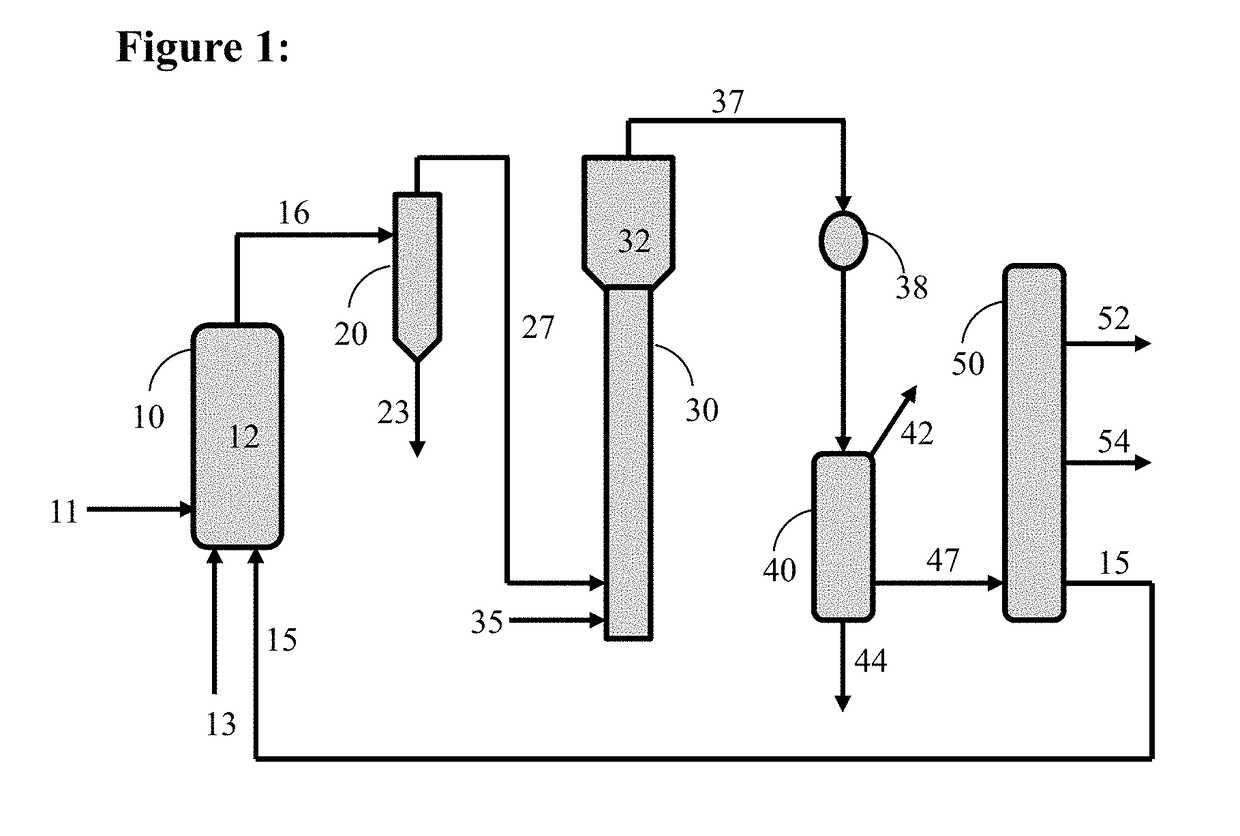Fluidized upgrading/hydrostabilizing of pyrolysis vapors
a technology of pyrolysis vapor and flue gas, which is applied in the direction of hydrocarbon dewatering, separation processes, instruments, etc., can solve the problems of low organic liquid yield, coke formation on the upgrading/hydrostabilizing catalyst, and potential problems in the use of a refinery feedstock as a refinery feedstock, so as to reduce the partial pressure of hydrogen required
- Summary
- Abstract
- Description
- Claims
- Application Information
AI Technical Summary
Benefits of technology
Problems solved by technology
Method used
Image
Examples
example 1
[0077]We investigated the recycling a heavy hydrocarbon fraction to the pyrolysis reactor in order to improve the yield of upgradeable pyrolysis vapors. We further examined whether co-pyrolysis of biomass and a heavy hydrocarbon fraction would help stabilize the highly reactive biomass pyrolysis intermediates (possibly through hydrocarbon thermal cracking and hydride transfer) and prohibit secondary reactions, thereby improving the quality of the pyrolysis vapor as well as the yield of upgraded product vapors leaving the upgrading / hydrostabilizing hydrostabilization reactor.
[0078]Table 1 shows the advantages of recycling a heavy hydrocarbon fraction to the pyrolysis reactor, demonstrated by co-pyrolysis of a biomass feedstock in the presence of vacuum gas oil (VGO) Table 1 shows results from co-pyrolysis of red oak and VGO in a micro-pyrolyzer connected with a GC-MS. The experiments detected components in the pyrolysis vapors from mixture of red oak+VGO, red oak alone, and VGO alone...
example 2
[0080]The upgrading / hydrostabilizing of pyrolysis vapors in a fluidized bed of catalyst was tested by contacting hot pyrolysis vapors (derived from biomass) with a fluidized bed of hydrodeoxygenation catalyst in a reactor. The pyrolysis vapors were formed by pyrolyzing a lignocellulosic feedstock in a pulsed-mode mini-pyrolyzer. The fluidized bed upgrading / hydrostabilizing reactor processed 60-120 g of biomass over the course of a 1-2 h run, generating sufficient products for analysis. Product vapors were analyzed including product quality, process yields, a lab-scale fluidized bed upgrading / hydrostabilizing reactor was designed and built.
[0081]Nitrogen gas was used to purge the biomass and to facilitate powder transport. The fluidization gas, which was one of hydrogen, nitrogen, or a mixture of the two, was fed into the bottom of the pyrolysis reactor. A 100 μm stainless steel (SS) frit was used as the gas distributor. The biomass was decomposed in the pyrolysis reactor, which cons...
example 3
[0086]A detailed analysis was conducted of the C5+ hydrocarbon products generated from fluidized upgrading / hydrostabilizing of pyrolysis vapors produced by the fluidized pyrolysis of a lignocellulosic biomass, as detailed in Example 2. A distribution of hydrocarbon species was obtained and compared to the spectrum of chemical species present in conventional crude oil feedstock. The dominant molecular species were identified and used to elucidate possible chemical pathways utilized during the upgrading / hydrostabilizing of the pyrolysis vapors. The structures of oxygenates remaining in the upgraded product were also identified and quantified.
[0087]FIG. 3 shows the distribution of C5+ hydrocarbons in the products. The hydrocarbon size distribution was determined by combining NOISE (Nitric Oxide Ionization Spectrometry Evaluation) analysis of liquid products with gas chromatography (GC) analysis of gaseous products.
[0088]Regarding the types of hydrocarbons, the fluidized upgrading / hydro...
PUM
| Property | Measurement | Unit |
|---|---|---|
| boiling point | aaaaa | aaaaa |
| boiling point | aaaaa | aaaaa |
| boiling point | aaaaa | aaaaa |
Abstract
Description
Claims
Application Information
 Login to View More
Login to View More - R&D
- Intellectual Property
- Life Sciences
- Materials
- Tech Scout
- Unparalleled Data Quality
- Higher Quality Content
- 60% Fewer Hallucinations
Browse by: Latest US Patents, China's latest patents, Technical Efficacy Thesaurus, Application Domain, Technology Topic, Popular Technical Reports.
© 2025 PatSnap. All rights reserved.Legal|Privacy policy|Modern Slavery Act Transparency Statement|Sitemap|About US| Contact US: help@patsnap.com



